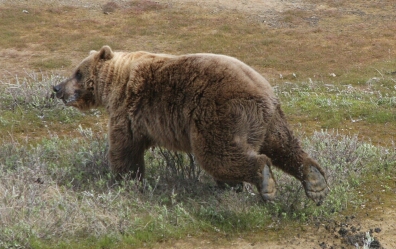Bears of the Cape Churchill Peninsula



These top (apex) predators share the landscape with healthy herds of caribou and moose as well as many species of nesting waterfowl. Current estimates of snow geese alone suggest that more than 75,000 pairs nest and raise their broods on the CCP. There are also large populations of Canada Geese and Common Eiders in the region. While there was once little overlap between polar bears and the nesting waterfowl, climate change is leading to earlier breakup of sea ice and to earlier onshore arrival of the polar bears. Taking advantage of the opportunity, polar bears are certainly consuming eggs as well as young geese and ducks. Grizzly and black bears have also been observed adding these abundant sources of prey to their diverse diets.
As the Hudson Bay Project has shifted to a more ecosystem level research paradigm, we are increasingly interested in the interactions both within and between trophic levels - soil to plants to herbivores to mesopredators (e.g. arctic foxes) to apex predators like the 3 species of bears on the CCP. We are especially interested in how trophic interactions (herbivory, predation and competition) influence the joint dynamics and abundances of species. Our work thus far indicates that the interactive effects are heavily influenced by both the means and variances of changing climate factors.
Drawing on a theme from local First Nation (Cree) elders, we are also examining how the bears themselves are responding to climate change. As part of that work, Linda Gormezano assessed temporal changes and spatial differences in polar bear diet using scat collected with a detection dog. She integrated those results with data we have collected for over 40 years on polar bear foraging during the ice free period and with Traditional Knowledge from members of the local First Nations and the Churchill community. Dave Iles initiated a study building on that work which aims to examine the extent and pattern of waterfowl nest predation by bears in relation to their age, social status and condition as well as the relation of such predation to ice and snow conditions. His information, based on an array of trail cameras, should allow us to better model the impacts of bear predation on snow goose abundance. Andrew Barnas and Sam Hervey, working with Susan Felege and Brian Darby (all from the University of North Dakota) are continuing that project and integrating genetic analyses of passively sampled hair and scat. They are also expanding the photographic work of Iles with constant video recording.
The Hudson Bay Project is participating fully in the educational outreach program sponsored by Bear Trust International. A direct link to that program can be found here. We are developing applications that will allow public input of data relevant to the goals of the Hudson Bay Project.
Recent papers from the Hudson Bay Project on bears from the CCP include:
Barnas, A, CJ Felege, RF Rockwell and SN Ellis-Felege. 2018. A pilot(less) study on the use of an unmanned aircraft system for studying polar bears. Polar Biology (in press)
Gormezano, Linda J., Susan N. Ellis-Felege, David T. Iles, Andrew Barnas and Robert F. Rockwell. 2017. Polar bear foraging behavior during the ice-free period in western Hudson Bay: observations, origins, and potential significance. American Museum Novitiates 3885, 28pp.
Gormezano, LJ, SR McWilliams, DT Iles and RF Rockwell. 2016. Costs of locomotion in polar bears: when do the costs outweigh the benefits of chasing down terrestrial prey? Conservation Physiology 4 CONPHYS-2016-028.R1/cow045
Gormezano, LJ and RF Rockwell. 2015. The Energetic Value of Land-Based Foods in Western Hudson Bay and Their Potential to Alleviate Energy Deficits of Starving AdultMale Polar Bears. PLOS ONE DOI:10.1371/journal.pone.0128520.
Gormezano, LJ and RF Rockwell. 2013. Dietary composition and spatial patterns of polar bear foraging on land in western Hudson Bay. BMC Ecology 13:51.
Gormezano, LJ and RF Rockwell. 2013. What to eat now? Shifts in terrestrial diet in western Hudson Bay. Ecology and Evolution 3(10): 3509–3523.
Iles, DT, SL Peterson, LJ Gormezano, DN Koons and RF Rockwell. 2013. Terrestrial predation by polar bears: not just a wild goose chase. Polar Biology 36:1373-1379.
Rockwell,RF, LJ Gormezano and DN Koons. 2011. Trophic matches and mismatches: can polar bears reduce the abundance of nesting snow geese in western Hudson Bay? Oikos 120: 696-709.
Rockwell, RF and LJ Gormezano. 2009. The early bear gets the goose: climate change, polar bears and lesser snow geese in Western Hudson Bay. Polar Biology 32:539-547.
Rockwell, RF, LJ Gormezano and D Hedmann. 2008. Grizzly Bears in Wapusk National Park, Northeastern Manitoba. Canadian Field-Naturalist 122(4) 323-326.A complete list of our publications can be found here.
Hudson Bay Project home page.